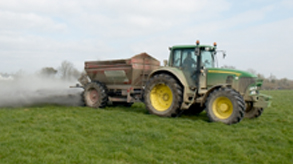WHY USE LIME?
Soil pH plays a key role in soil fertility. Maintaining the soil pH at the optimum level will increase the microbiological activity of the soil and will result in better soil nutrient recycling and release. Soil pH is also critical for maximising the availability of nutrients applied in organic and chemical fertilisers. Lime is a soil conditioner. It corrects soil acidity by neutralising the acids in soils so that the micro-organisms can thrive, break down plant and animal residues and release the elements necessary for healthy plant growth, in particular nitrogen, phosphorus and potassium.
According to Teagasc, only 35% of soil samples from dairy and drystock farms nationally are at the optimum pH for grassland. By optimising pH, soils can release up to 80kg/ha /year of nitrogen. Lime is a cheap input relative to the cost of fertilisers.
Over 60% of Irish grassland soils have low pH and each hectare uses up 0.5 to 1.0 tonnes of lime per year. Lime is continually being lost from the soil and needs to be replaced as part of any nutrient management programme. For example drainage water can remove between 250 kg/ha and 625 kg/ha, depending on the soil type, of lime each year. Light free draining soils will lose lime more quickly than heavier soils. Therefore light land may need extra attention, particularly in areas where limestone is not present in soil parent material or bedrock. Crops and livestock also remove lime. For example, a crop of first cut grass silage (5t/ha DM) removes approximately 75 kg/ha of lime equivalent. A finished bullock removes approximately 25 kg/ha while cows producing 1,000 litres of milk removes approximately 3kg of lime per hectare.
Lime improves the availability of Nitrogen, Phosphorus, Potassium, Sulphur, Calcium & Magnesium. The chemical availability of many nutrients are reduced in soils with low pH. For example in the case of phosphorus, soils with a low pH tend to lock up the phosphorus, making it unavailable for plant uptake. Applying additional phosphorus in this case is poor value for money. The low pH means that the potential of the soil to release phosphorus is not fully realised and some of the phosphorus in the fertilizer is locked up.
Experiments have shown that soil test phosphorus (P) levels after 12 months were over twice as high where fertiliser P and lime were applied together, compared to where P was applied on its own. The same experiments also showed that lime application had a positive effect on soil test P even where no P was applied.
Acidic soils due to the lack of lime can also contain high levels of Aluminium and Manganese which are harmful in varying degrees to many plants.
Lime stimulates the release of N from soil organic matter. A clear pattern between N and lime interaction has long been proven.
We are standing on tonnes of organic nitrogen. Putting out Lime and correcting your pH increases biological activity and can release up to 80kgs of N per hectare per year. This is the equivalent of a bag of Urea (per acre).
When P fertiliser is applied to the soil, the phosphate reacts to form Ca phosphates at high pH levels and al/fe phosphates when the soil pH is too low. This means that in acid soils most of the very expensive P that is applied is fixed in the soil and is not available to the roots of the plants.
Where there is constant pressure on P usage, it makes no sense to have acidic soils.
Lime provides a valuable source of calcium which helps to flocculate the soil.
Flocculated soils are more open. They allow for better water percolation down through the soil and, at the same time, facilitate root growth and air transfer. They are less tight and may be somewhat easier to work.
Growing as much grass as possible is the best opportunity to reduce on-farm costs. Soils maintained close to the target pH will have benefits of increased grass yields; more efficient utilisation of applied fertilisers and manures and better persistence of more productive species in the sward such as perennial ryegrass and clover. Limed soils also tend to release more Nitrogen from the soil organic matter. The ideal pH for grassland soils is pH 6.3.
By applying lime every couple of years it will help improve grass availability, raise soil pH and help condition the soil, this in turn will improve nutrient availability and soil structure. With better soil structure comes improved drainage, which allows for better root development and nutrient uptake.
Because of its massive benefits, the first fertiliser money to be spent on every farm should be on lime!
Soil pH is critical to the availability of all nutrients and is the most important factor in improving soil fertility.
The pH of the soil is extremely important as certain nutrient elements become unavailable, especially phosphorus, if the pH is too high or too low. Soil pH is a measure of the soil acidity or alkalinity. It is based on a scale from 1-14 where 7 is neutral. At a pH less than 7 the soil is considered acidic while above 7 the soil is considered alkaline. The optimum use of fertilisers that contain N,P and K is achieved when soil pH is between 6 and 7.
In summary low soil pH will result in lower availability of the nutrients in the soil and poorer response to applied fertilisers and organic manures. Unfortunately Teagasc, the Irish Agriculture and Food Development Authority estimates that two-thirds of Irish grassland soils have a pH of less than 6.2 which is a serious limiting factor for crop production.
Before re-seeding it is important to carry out a soil sample test. If a field is underperforming the real issue needs to be identified as re-seeding may not be the solution. A soil sample test however will determine the soil pH level. If a field is highly acidic or is lacking in soil nutrients, high grass growth will still struggle even if re-seeding is carried out. If there is a low pH then lime should be applied to resolve this. Soil testing helps identify the real issue and eliminates any unnecessary or incorrect treatment.
















